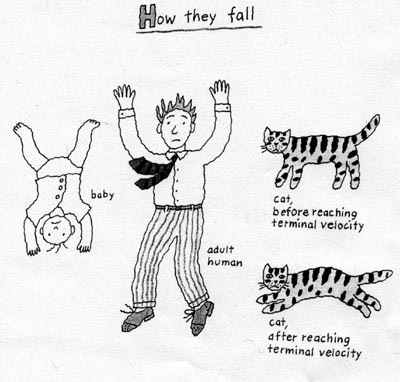

The Falling Cat problem is a lovely example of the
application of gauge theory to problems in
mechanics and control. Richard Montgomery's
beautiful "Falling Cat Theorem," relates optimal
reorientation of the falling cat to the dynamics of
particles in Yang-Mills fields. On his webpage, he
states,
"The cat flips itself right side up, even
though its angular momentum is
zero. It does this by changing its
shape. In terms of gauge theory, the
shape space of the cat forms the
base space of a principal
SO(3)-bundle, and the statement
"angular momentum equals zero"
defines a connection on this bundle."


I got these picture from
http://www.cco.caltech.edu/~mleok/falling_cats.htm
Here is some examples of how different shaped objects fall.
After a cat reaches terminal velocity it relaxes because it doesn't
feel the acceleration of gravity anymore. When it relaxes it
spreads out and increases its drag and starts to slow down.
When it lands in this position the impact is spread out on more of
its body so it is less likely to get injured or kill itself.

I got this nice pic from
Diamond, Jared. "How Cats Survive Falls from New York
Skyscrapers," Natural History 20-26; August 1989.


I got these two pics from
Fredrickson, J. E. "The tail-less cat in free-fall," The
Physics Teacher. 27, 620-625; November 1989.
I didn't copy the picture of the tail-less cat. I thought it
was just too cruel throwing tail-less cats around.